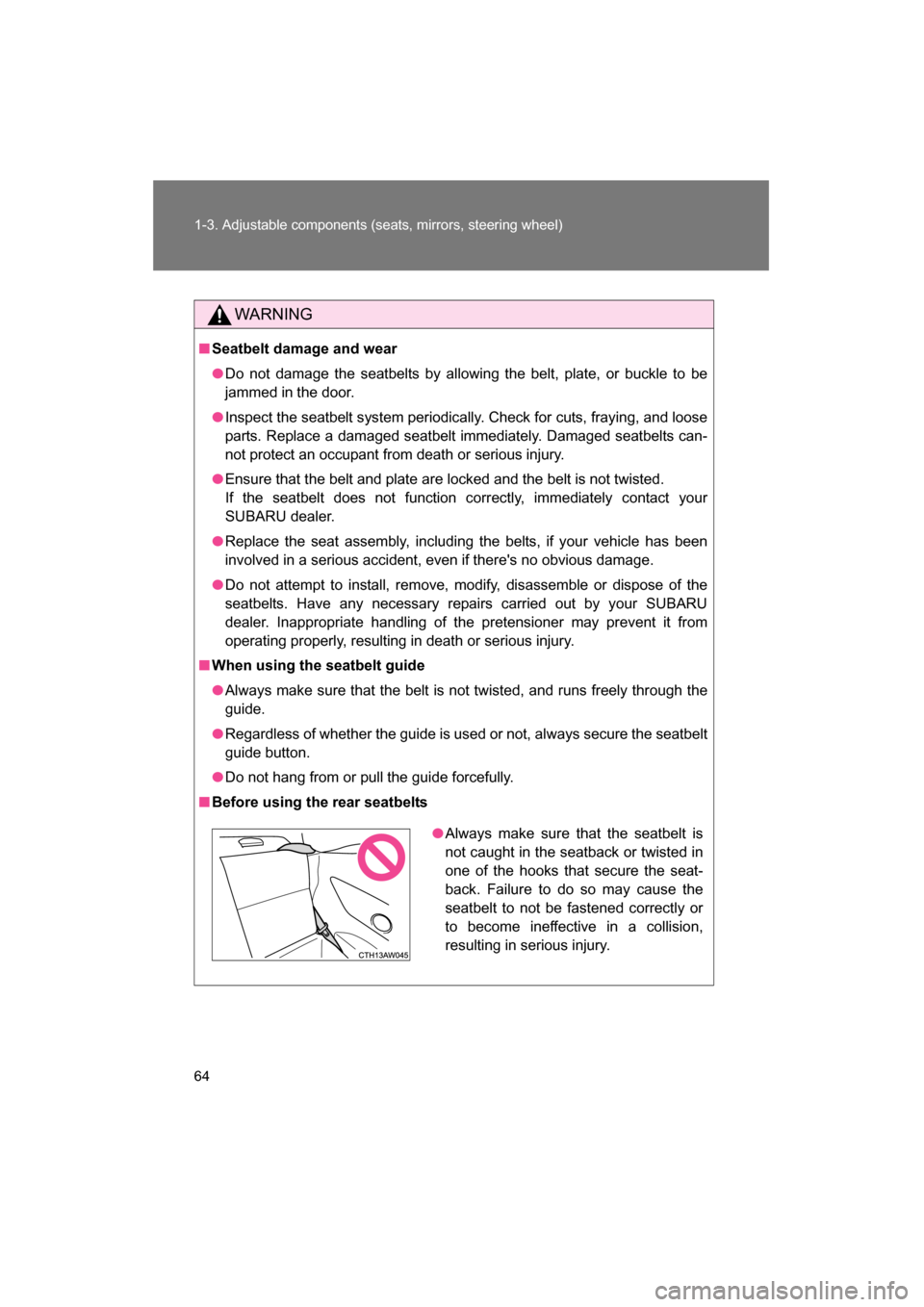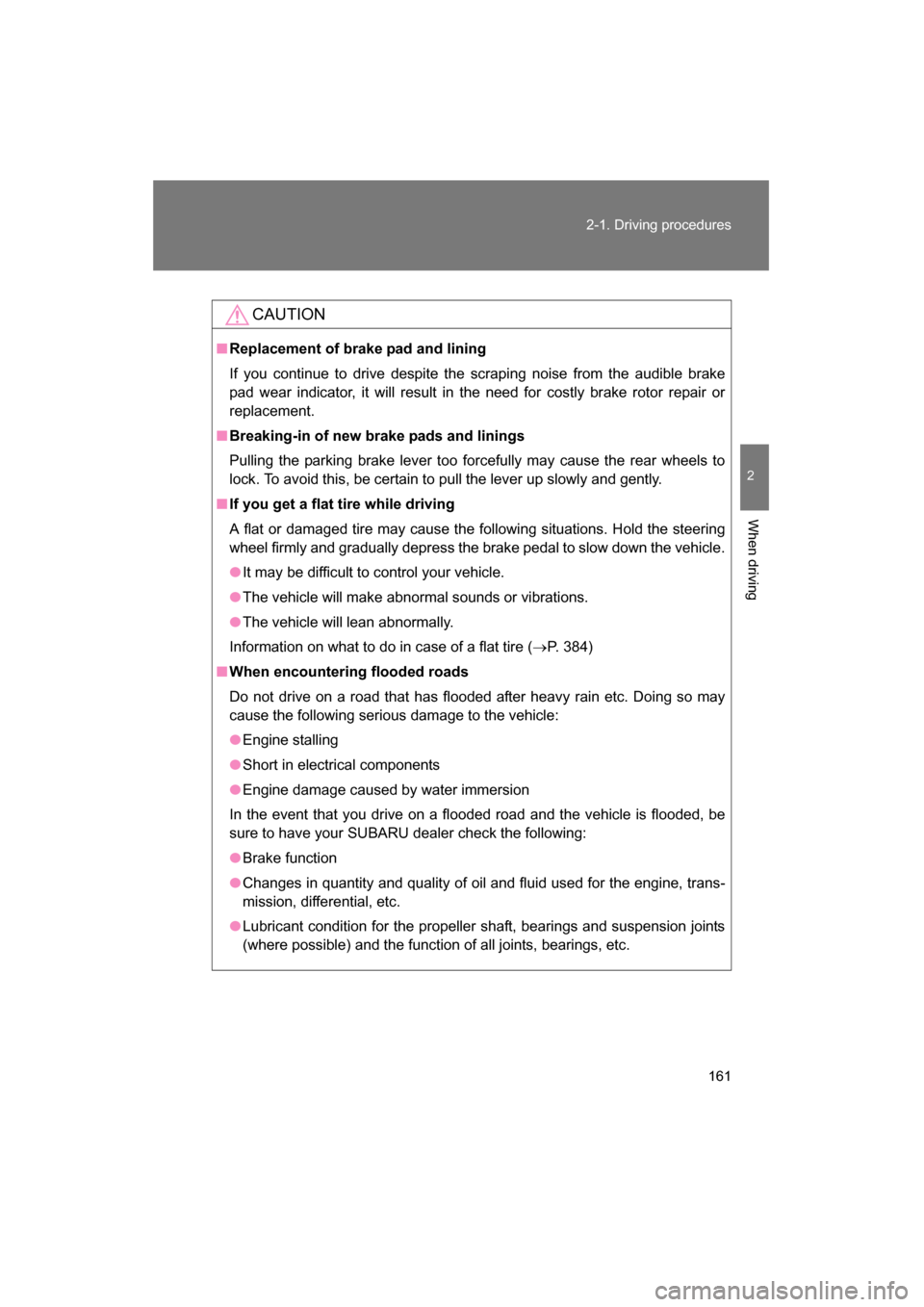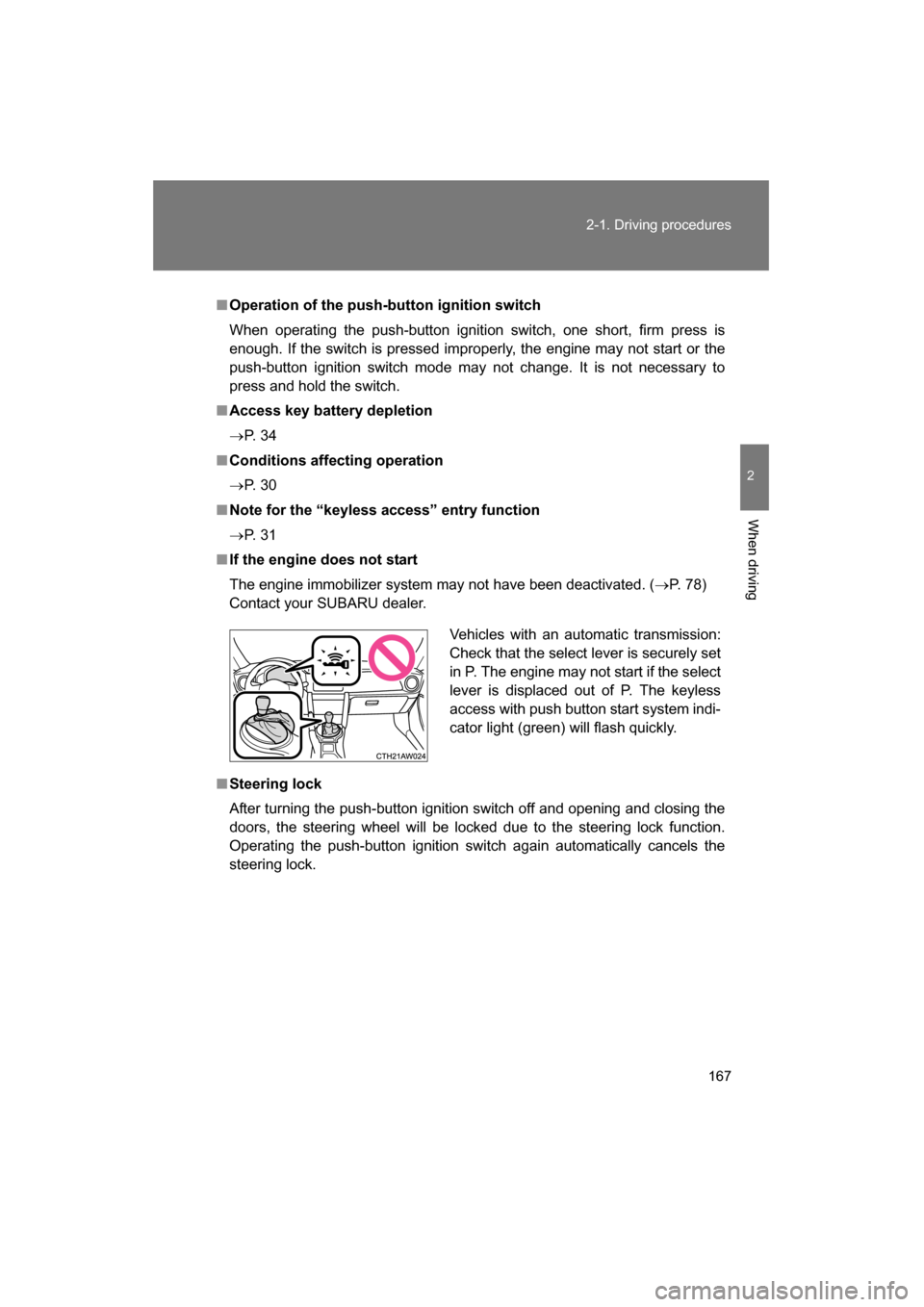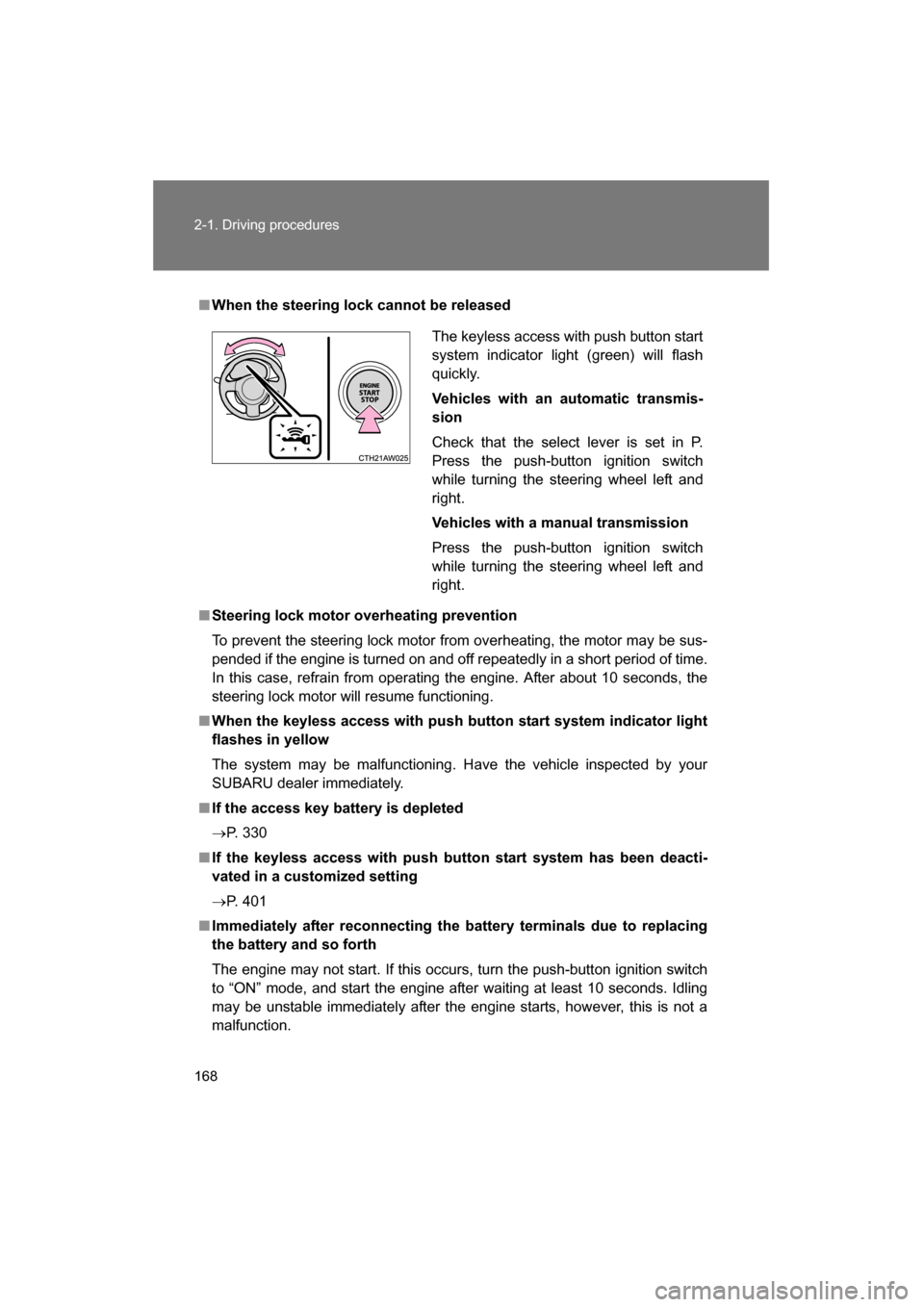Page 60 of 492

60
1-3. Adjustable components (seats, mirrors, steering wheel)
■Emergency locking retractor (ELR)
The retractor will lock the belt during a sudden stop or on impact. It may also
lock if you lean forward too quickly. A slow, easy motion will allow the belt to
extend so that you can move around fully.
■Automatic locking retractor (ALR)
When a passenger's shoulder belt is completely extended and then
retracted even slightly, the belt is locked in that position and cannot be
extended. This feature is used to hold the child restraint system (CRS) firmly.
To free the belt again, fully retract the belt and then pull the belt out once
more. (→P. 137)
■Child seatbelt usage
The seatbelts of your vehicle are principally designed for persons of adult
size.
●Use a child restraint system appropriate for the child, until the child
becomes large enough to properly wear the vehicle's seatbelt. (→ P. 133)
●When the child becomes large enough to properly wear the vehicle's
seatbelt, follow the instructions on P. 58 regarding seatbelt usage.
■Seatbelt pretensioners
●Seatbelt pretensioners are not designed to activate in minor frontal or
side impact, in rear impacts or in roll-over accidents.
●The following four components operate simultaneously when the vehicle
is subjected to a severe frontal collision.
Page 64 of 492

64
1-3. Adjustable components (seats, mirrors, steering wheel)
WARNING
■Seatbelt damage and wear
●Do not damage the seatbelts by allowing the belt, plate, or buckle to be
jammed in the door.
●Inspect the seatbelt system periodically. Check for cuts, fraying, and loose
parts. Replace a damaged seatbelt immediately. Damaged seatbelts can-
not protect an occupant from death or serious injury.
●Ensure that the belt and plate are locked and the belt is not twisted.
If the seatbelt does not function correctly, immediately contact your
SUBARU dealer.
●Replace the seat assembly, including the belts, if your vehicle has been
involved in a serious accident, even if there's no obvious damage.
●Do not attempt to install, remove, modify, disassemble or dispose of the
seatbelts. Have any necessary repairs carried out by your SUBARU
dealer. Inappropriate handling of the pretensioner may prevent it from
operating properly, resulting in death or serious injury.
■When using the seatbelt guide
●Always make sure that the belt is not twisted, and runs freely through the
guide.
●Regardless of whether the guide is used or not, always secure the seatbelt
guide button.
●Do not hang from or pull the guide forcefully.
■Before using the rear seatbelts
●Always make sure that the seatbelt is
not caught in the seatback or twisted in
one of the hooks that secure the seat-
back. Failure to do so may cause the
seatbelt to not be fastened correctly or
to become ineffective in a collision,
resulting in serious injury.
Page 65 of 492
65
1
1-3. Adjustable components (seats, mirrors, steering wheel)
Before driving
Steering wheel
WARNING
■Caution while driving
Do not adjust the steering wheel while driving.
Doing so may cause the driver to mishandle the vehicle and an accident,
resulting in death or serious injury.
■After adjusting the steering wheel
Make sure that the steering wheel is securely locked.
Otherwise, the steering wheel may move suddenly, possibly causing an
accident, and resulting in death or serious injury.
The steering wheel can be adjusted to a comfortable position.
Hold the steering wheel and
push the lever down.
Adjust to the ideal position by
moving the steering wheel
horizontally and vertically.After adjustment, pull the lever
up to secure the steering
wheel.
STEP 1
STEP 2
Page 86 of 492
86
1-7. Safety information
Correct driving posture
Drive with a good posture as follows:Sit upright and well back in
the seat. (→P. 5 1 )
Adjust the position of the
seat forward or backward to
ensure the pedals can be
reached and easily
depressed to the extent
required. ( →P. 51)
Adjust the seatback so that
the controls are easily oper-
able. ( →P. 5 1 )
Adjust the tilt and telescopic
positions of the steering
wheel to allow easy opera-
tion and to ensure the air-
bag is facing your chest. ( → P. 6 5 )
Lock the head restraint in
place with the center of the
head restraint closest to the
top of your ears. ( → P. 5 6 )
Wear the seatbelt correctly.( → P. 5 8 )
Page 149 of 492

149
2-1. Driving procedures
2
When driving
■Parking the vehicle
Vehicles with an automatic transmission With the select lever in D, depress the brake pedal.
Shift the select lever to P. ( →P. 174)
Set the parking brake. ( →P. 185)
Vehicles without a keyless access with push button start
system:
Turn the engine switch to the “LOCK” position to stop the
engine.
Vehicles with a keyless access with push button start sys-
tem:
Press the push-button ignition switch to stop the engine.
Lock the door, making sure that you have the key on your
person.
If parking on a hill, block the wheels as needed.
Vehicles with a manual transmission While depressing the clutch pedal, depress the brake
pedal.
Shift the shift lever to neutral. ( →P. 181)
Set the parking brake. ( →P. 185)
Vehicles without a keyless access with push button start
system:
Turn the engine switch to the “LOCK” position to stop the
engine.
Vehicles with a keyless access with push button start sys-
tem:
Press the push-button ignition switch to stop the engine.
Lock the door, making sure that you have the key on your
person.
If parking on a hill, shift the shift lever to 1 or R and block the
wheels as needed.
STEP 1
STEP 2
STEP 3
STEP 4
STEP 5
STEP 1
STEP 2
STEP 3
STEP 4
STEP 5
Page 161 of 492

161
2-1. Driving procedures
2
When driving
CAUTION
■Replacement of brake pad and lining
If you continue to drive despite the scraping noise from the audible brake
pad wear indicator, it will result in the need for costly brake rotor repair or
replacement.
■Breaking-in of new brake pads and linings
Pulling the parking brake lever too forcefully may cause the rear wheels to
lock. To avoid this, be certain to pull the lever up slowly and gently.
■If you get a flat tire while driving
A flat or damaged tire may cause the following situations. Hold the steering
wheel firmly and gradually depress the brake pedal to slow down the vehicle.
●It may be difficult to control your vehicle.
●The vehicle will make abnormal sounds or vibrations.
●The vehicle will lean abnormally.
Information on what to do in case of a flat tire ( →P. 384)
■When encountering flooded roads
Do not drive on a road that has flooded after heavy rain etc. Doing so may
cause the following serious damage to the vehicle:
●Engine stalling
●Short in electrical components
●Engine damage caused by water immersion
In the event that you drive on a flooded road and the vehicle is flooded, be
sure to have your SUBARU dealer check the following:
●Brake function
●Changes in quantity and quality of oil and fluid used for the engine, trans-
mission, differential, etc.
●Lubricant condition for the propeller shaft, bearings and suspension joints
(where possible) and the function of all joints, bearings, etc.
Page 167 of 492

167
2-1. Driving procedures
2
When driving
■Operation of the push-button ignition switch
When operating the push-button ignition switch, one short, firm press is
enough. If the switch is pressed improperly, the engine may not start or the
push-button ignition switch mode may not change. It is not necessary to
press and hold the switch.
■Access key battery depletion
→ P. 3 4
■Conditions affecting operation
→P. 3 0
■Note for the “keyless access” entry function
→P. 3 1
■If the engine does not start
The engine immobilizer system may not have been deactivated. ( →P. 78)
Contact your SUBARU dealer.
■Steering lock
After turning the push-button ignition switch off and opening and closing the
doors, the steering wheel will be locked due to the steering lock function.
Operating the push-button ignition switch again automatically cancels the
steering lock. Vehicles with an automatic transmission:
Check that the select lever is securely set
in P. The engine may not start if the select
lever is displaced out of P. The keyless
access with push button start system indi-
cator light (green) will flash quickly.
Page 168 of 492

168
2-1. Driving procedures
■When the steering lock cannot be released
■Steering lock motor overheating prevention
To prevent the steering lock motor from overheating, the motor may be sus-
pended if the engine is turned on and off repeatedly in a short period of time.
In this case, refrain from operating the engine. After about 10 seconds, the
steering lock motor will resume functioning.
■When the keyless access with push button start system indicator light
flashes in yellow
The system may be malfunctioning. Have the vehicle inspected by your
SUBARU dealer immediately.
■If the access key battery is depleted
→P. 330
■If the keyless access with push button start system has been deacti-
vated in a customized setting
→ P. 401
■Immediately after reconnecting the battery terminals due to replacing
the battery and so forth
The engine may not start. If this occurs, turn the push-button ignition switch
to “ON” mode, and start the engine after waiting at least 10 seconds. Idling
may be unstable immediately after the engine starts, however, this is not a
malfunction. The keyless access with push button start
system indicator light (green) will flash
quickly.
Vehicles with an automatic transmis- sion
Check that the select lever is set in P.
Press the push-button ignition switch
while turning the steering wheel left andright.
Vehicles with a manual transmission
Press the push-button ignition switch
while turning the steering wheel left andright.